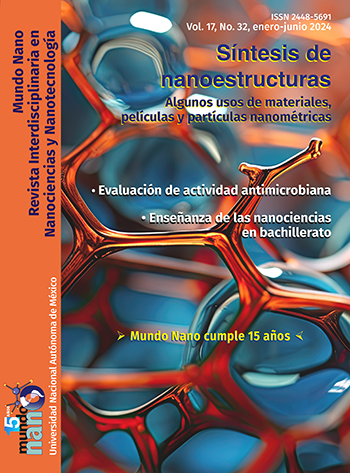Effect of temperature on the formation of luminescent nanostructures in KBr:Eu2+
Main Article Content
Abstract
The study of the effect of temperature on the formation of luminescent nanostructures (NsL) in the single crystal of KBr:Eu2+ is presented. The samples were stored for 16 weeks at 100 and 200 °C to form the Suzuki phase (FS) and dihalide phase (FD), respectively, the concentration of impurities in both cases was ~380 ppm. The formation of nanostructures was studied by optical spectroscopy (OE) and the images were obtained by atomic force microscopy (AFM). The absorption and emission spectra report important changes in 10 Dq for the FS at 11365.2 cm–1, with a mission peak at 433 nm, and for the FD 10 Dq at 5319.3 cm–1 with two characteristic emission peaks at 428.5 and 450.7 nm of the dihalide phase. The images observed by AFM show that the NsL for the FS range from 40 to 435 nm in diameter with heights of 9 to 120 nm, in contrast to the FD where there is a dispersion of sizes is from 20 nm to 500 nm in diameter, but with limited heights in the range 1 to 7 nm. These results prove theoretical suppositions that indeed the DF is of the laminar type, the results obtained are in agreement with the literature data.
Downloads
Article Details

Mundo Nano. Revista Interdisciplinaria en Nanociencias y Nanotecnología por Universidad Nacional Autónoma de México se distribuye bajo una Licencia Creative Commons Atribución-NoComercial 4.0 Internacional.
Basada en una obra en http://www.mundonano.unam.mx.
References
Aguilar M., Rubio, O., López F. et al. (1982). Optical absorption and fluorescence investigation of the precipitate phases of Eu2+ in KBr single crystals. Solid State Communications, 44(2): 141-144. DOI: https://doi.org/10.1016/0038-1098(82)90417-3
Bannon, N. M., Corish J. y Jacobs, P. W. M. (1985). A theoretical study of the formation and aggregation of vacancy-impurity dipoles in divalently doped alkali halide crystals. Philosophical Magazine A, 51(6): 797-814. https://doi.org/10.1080/01418618508237588. DOI: https://doi.org/10.1080/01418618508237588
Cordero-Barboa A. E., Jiménez-García L. F. (2005). Epifluorescence optical microscopy: a sensitive tool for determining the spatial distribution of europium-dihalide precipitates in KCl:KBr:Eu2+ crystals. Philosophical Magazine Letters, 85: 345-357. https://doi.org/10.1080/09500830500229378. DOI: https://doi.org/10.1080/09500830500229378
Cordero-Borboa A. E. y Unda-Angeles R. (2021). Quadruple node of triple junctions of grain boundaries in a Eu2+-doped solid solution of the ions K+, Rb+, Cl− and Br−: an epifluorescence microscopy study using the doping ion as a fluorochrome. Microscopy, dfab047. https://doi.org/10.1093/jmicro/dfab047. DOI: https://doi.org/10.1093/jmicro/dfab047
Delgado Medina, José Nicolás. (2012). Formación de nanoestructuras de europio en matriz de KBr por efecto de la temperatura, tesis de licenciatura, asesorada por E. V. Mejía-Uriarte. Universidad Nacional Autónoma de México, México. https://ru.dgb.unam.mx/handle/DGB_UNAM/TES01000695887.
Farzaneh A. y Reza Abdi M. (2018). CsI nanocrystal doped with Eu2+ ions for radiation detection. Journal of Luminescence, 194: 424-427. https://doi:10.1016/j.jlumin.2017.10.034. DOI: https://doi.org/10.1016/j.jlumin.2017.10.034
Hernández J., Cory W. K. y Rubio O. (1980). Optical investigation of divalent europium in the alkali chlorides and bromides. Journal Chemistry of Physics. 72:198-205. https://doi.org/10.1063/1.438875. DOI: https://doi.org/10.1063/1.438875
Horcas, I., Fernández, R., Gómez-Rodríguez, J., Colchero, J., Gómez-Herrero, J. y Baro, A. (2007). WSXM: A software for scanning probe microscopy and a tool for nanotechnology. Review Scientific Instrument, 78: 013705-1-013705-8. https://doi.org/10.1063/1.2432410. DOI: https://doi.org/10.1063/1.2432410
Kim, H. J., Rooh G., Khan A., Park, H., Kim, S. (2018). Scintillation performance of the TlSr2I5 (Eu2+) single crystal. Optical Materials, 82: 7-10. https://doi.org/10.1016/j.optmat.2018.05.036. DOI: https://doi.org/10.1016/j.optmat.2018.05.036
López, F. J., Murrieta, H., Hernández, J. Rubio, O. (1980). Optical absorption and luminescence investigations of the precipitated phases of Eu2+ in NaCl and KCl single crystals. Journal Physics Rev B, 22: 6428-6439. https://doi.org/10.1103/PhysRevB.22.6428. DOI: https://doi.org/10.1103/PhysRevB.22.6428
Mejía-Uriarte, E. V., Castañeda-Guzmán, R., Villagrán-Muniz, M., Camarillo, E., Hernández, J., Murrieta, H. y Navarrete, M. (2003). Studies of the thermal dissolution process of the Suzuki phase of the Eu2+ ion in KBr single crystals by analysis of the photoacoustic signals. Journal Physics: Condensed Matter 15(40): 6889-6898. https://doi.org/10.1088/0953-8984/15/40/024. DOI: https://doi.org/10.1088/0953-8984/15/40/024
Mejía-Uriarte, E. V., Navarrete, M, Villagrán-Muniz, M, Camarillo, E., Hernández, J. y Murrieta, H. (2005a). Dissolution studies about the aggregate-precipitate of the divalent europium ions into KBr crystals by photoacoustic technique. Journal de Physique IV, 125: 277-280. https://doi.org/10.1051/jp4:2005125066. DOI: https://doi.org/10.1051/jp4:2005125066
Mejía-Uriarte, E. V., Camarillo, E., Hernández, J., Navarrete, M., Villagrán-Muniz, M. y Murrieta, H. (2005b). Thermal dissolution of Eu2+ Suzuki phase nanostructures in KBr crystals monitored by pulsed photoacoustic and photoluminescence techniques. Optical Materials, 27(7): 1316-1319. https://doi.org/10.1016/J.OPTMAT. DOI: https://doi.org/10.1016/j.optmat.2004.11.030
Mejía-Uriarte, E. V., Bañuelos, J., Kolokoltsev, O. et al. (2009a). Influence of europium nanostructure size on the emission of KBr:Eu2+. Solid State Communications, 149: 445-447. https://doi.org/10.1016/J.SSC. DOI: https://doi.org/10.1016/j.ssc.2008.12.042
Mejía-Uriarte, E. V., Bañuelos, J., Kolokoltsev, O. et al. (2009b). Self-assembled rings EuBr2 nanostructures. Materials Letters, 63(5): 554-556. https://doi.org/10.1016/J.MATLET.2008.11.039. DOI: https://doi.org/10.1016/j.matlet.2008.11.039
Mejía-Uriarte, E.V., Kolokoltsev, O., Navarrete, M., et al. (2015). Study of NaCl:Mn2+ nanostructures in the Suzuki phase by optical spectroscopy and atomic force microscopy. Journal of Luminescence, 160: 293-298. https://doi.org/10.1016/J.JLUMIN.2014.12.015. DOI: https://doi.org/10.1016/j.jlumin.2014.12.015
Muñoz Santiuste, J. E. y García Solé, J. (1988). Precipitation-induced quenching of Eu2+ luminescence in NaCl:EuCl2. Physical Review B, 38, 10874. DOI: https://doi.org/10.1103/PhysRevB.38.10874
Stand, L., Zhuravleva, M. y Melcher, H. C. L. (2015). Crystal growth and scintillation properties of potassium strontium bromide. Optical Materials, 46: 59-63. https://doi.org/10.1016/j.optmat.2015.04.002. DOI: https://doi.org/10.1016/j.optmat.2015.04.002
Soundara Pandian, L. et al. (2021). TlSr2I5:Eu2+ - A new high-density scintillator for gamma-ray detection. Nuclear Instruments and Methods in Physics Research Section A: Accelerators, Spectrometers, Detectors and Associated Equipment, 988: 164876. https://doi.org/10.1016/j.nima.2020.164876. DOI: https://doi.org/10.1016/j.nima.2020.164876
Suzuki, K. (1961). X-ray studies on precipitation of metastable centers in mixed crystals NaCl-CdCl2. Journal of the Physical Society of Japan, 6(1): 67-78. https://doi.org/10.1143/JPSJ.16.67. DOI: https://doi.org/10.1143/JPSJ.16.67
Zaldo, C., Orozco, E., Mendoza, A. y Rubio, O. (1985). Eu precipitation in plastically deformed alkali halides. Journal of Physics D: Applied Physics, 18(2): 247-258. https://doi.org/10.1088/0022-3727/18/2/012. DOI: https://doi.org/10.1088/0022-3727/18/2/012





